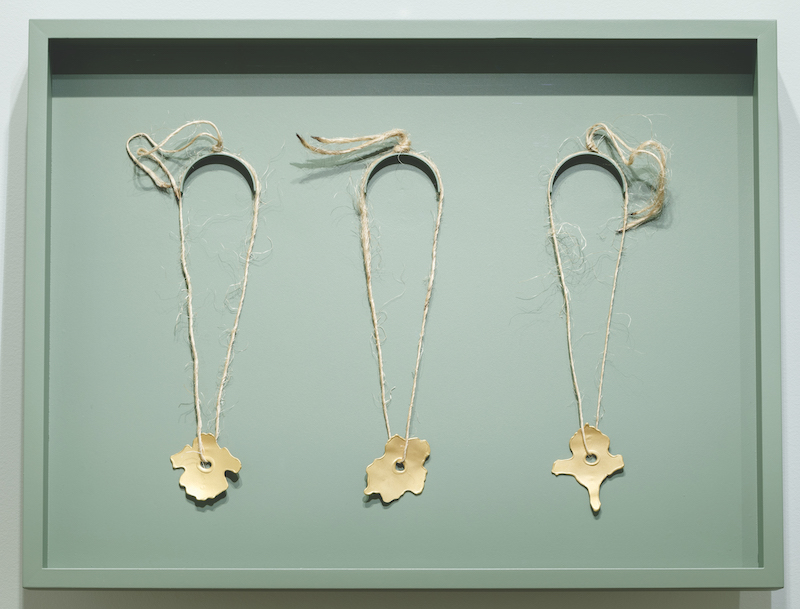To wear an object of jewellery made by artist Areta Wilkinson (Ngāi Tahu) is to embrace a bodily experience revealed through many layers of deeply held connections. “Consistent is a maker’s conversation across time, linking my creative practice with that of my ancestors connected by the hand and body,” says the artist, who is represented by Two Rooms Gallery, Auckland.
Wilkinson resides at the foothills of the Southern Alps, once Ngāi Tahu territory. It is clear that her art practice is informed by applied knowledge of jewellery making practices and collective Ngāi Tahu knowledge activated into wearable taonga (prized possessions). “My work is always about looking for relationships,” she says. “That is what the Māori concept of whakapapa (genealogy links) is all about, seeking to find and layer up the relationships.”
The work Hei Ata Āhua is a great example – commissioned by curator Nigel Borell for Toi Tū Toi Ora, a major 2020-2021 survey of contemporary Māori art at Auckland Art Gallery Toi o Tāmaki. Now in the permanent collection, the work, created from South Island gold, may be worn on special occasions as decided by the gallery. The ambition is to gain provenance and potency as it is passed from one pair of hands to another, challenging the hands-off way art institutions engage with collection objects. With its title referencing form, shape, shadows of the past and new meanings of beauty and desire, the work connects back to the shadow of a Hei Tiki collected on one of James Cook’s voyages and housed in the Pitt Rivers Museum collection, Oxford, England. Wilkinson and her partner, fellow artist Mark Adams, worked collaboratively to create photograms of museum objects thanks to the Museum of Archaeology and Anthropology in Cambridge, England.
Developing this work, her 2014 Doctoral Fine Arts thesis from Massey University Te Kunenga ki Pūrehuroa, Palmerston North, researched the topic of Jewellery as pepeha: Contemporary jewellery practice informed by Māori inquiry.
Embracing key markers of identity and place was central to a 2020-21 exhibition of Wilkinson’s work at Christchurch Art Gallery Te Puna o Waiwhetū called Moa-Hunter Fashions, an extension of her 2019 offering for Brisbane’s Asia Pacific Triennial of Contemporary Art. Three core installations revealed cultural markers – the whenua/land, the awa/river and the maunga/mountain. Shingle and anvil stones from the Waimakariri River were brought into the gallery, sounds of water flowed from a nearby video work. A shelf of 3D printed objects referenced ancestral tools, such as hammer stone, drill and blade. Ceramic objects of adornment were made using these tools from locally sourced clay. Gold pendant shapes were derived from photograms of moa bone vertebrae. The transmission of knowledge continued with hands-on public workshops.
Expanding this sense of continuity between time past and time passed, Wilkinson’s 2020 work, made during a Covid-19 lockdown period, was featured in the recent exhibition Mark Work at The Centre of Contemporary Art Gallery, Christchurch. Ka Taka Te Wā – Time Passed involves a 15-metre horizontal line of cord tracing along the gallery wall like a timeline, intersected 36 times by hanging silver and gold discs graded from darkly oxidised to brightly gold plated, one for each day of lockdown. While it effectively marked creation of time as it emerged from darkness to the light, from not knowing to knowing, it did not seek to portray time as a purely linear dimension but rather as an embodiment of connected, simultaneously experienced moments in time. “What is the beginning and what is the end?” she asks.
Mark Work travels to Objectspace, Auckland in early 2022. Wilkinson is part of the Ngāi Tahu visual artist collective Paemanu, which has an upcoming 2022 project at Dunedin Public Art Gallery. Wilkinson’s work is held in major collections throughout Aotearoa and world-wide.
Featured image: Areta Wilkinson, Moa-hunter Fashions Series: Vertebrae I-III, 2017. 24ct Ōtākou gold, flax bailing twine. Photo: John Collie. Courtesy: the artist and Two Rooms Gallery, Auckland.

